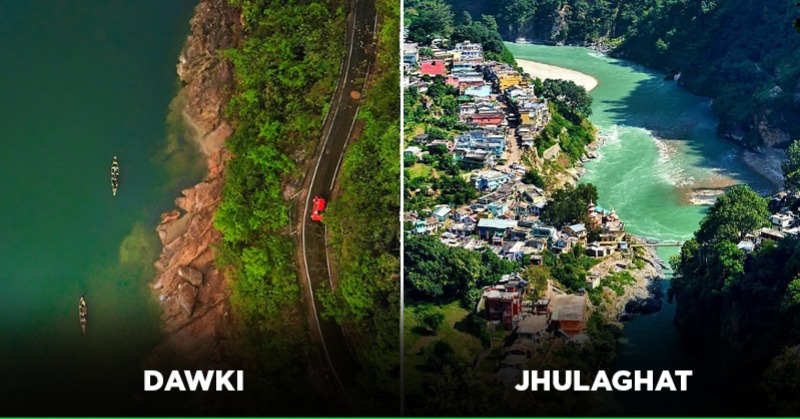India, a country with diverse landscapes and a rich cultural heritage, conceals a plethora of the last existing villages within its vast breadth. These hidden gems, unaffected by modernization, provide a look into the country’s authentic rural existence. We set out on a trek across India’s last villages, taking the back roads and discovering the charm of these fading hamlets.
As we visit these rural settlements, we meet a vibrant tapestry of time-honoured traditions and customs. These villages become living museums of India’s cultural legacy, with everything from age-old rituals to traditional crafts and folk arts.
Stepping into these communities seems like stepping back in time, with their architectural marvels testifying to their rich history. Intricately carved temples, antique havelis (mansions), and traditional mud cottages highlight the local artists’ extraordinary artistry and creativity.
Let’s take this trip to India‘s most amazing and beautiful villages, which are at the Indian border.
Jump To
![]()
A Journey Through India’s Last Villages: The Road Less Travelled
These villages are the most beautiful places and have been known by very few people. So, if you are planning your trip this vacation, then these places are a must-visit. Also, you can explore the nearby places, which will make your trip more memorable.
1. Chitkul, Himachal Pradesh

Instagram/mountainmysteries
Chitkul is a tiny village in the Himachal Pradesh district of Kinnaur. It is sometimes called the last inhabited village on the Indo-Tibetan border, at an elevation of roughly 3,450 metres (11,319 feet). Chitkul is well-known for its breathtaking natural beauty, scenic landscapes, and diverse cultural history.
The Himalayan territory is located in the Himalayas and offers stunning vistas of snow-capped mountains, including the majestic Kinner Kailash peak. The Baspa River flows through Chitkul, adding to the area’s beauty. The location is bordered by lush woods, alpine meadows, and apple orchards, making it a perfect destination for hikers and environmental enthusiasts.
The best time to visit this place is from May to October, and during the visit, you can explore the mesmerising waterfalls, which will make you stop for sure.
Nearest Railway Station: Shimla
2. Dawki, Meghalaya

Instagram/tilted_photographer
Dawki is a picturesque hamlet in Meghalaya’s West Jaintia Hills district. It is well-known for its breathtaking natural beauty and is frequently called the final village on the Indo-Bangladesh border. Dawki, located near the crystal-clear Umngot River, provides stunning views of the verdant hills and blue seas.
The town is well-known for its living root bridges, which are made by training the roots of rubber trees to make strong bridges spanning streams. Dawki draws tourists with its tranquil ambience, boating options, and the yearly boat race on the Umngot River, making it an enthralling location for nature lovers.
Nearest Railway Station: Guwahati Railway Station
3. Mana, Uttrakhand

Instagram/ghumakkadyaar_
Mana is a charming village in Uttarakhand’s Chamoli district that is frequently considered the last inhabited village near the Indo-Tibetan border. Mana is noted for its magnificent natural beauty and spiritual importance and is located at around 3,200 metres (10,500 feet).
It is thought to be the home of the legendary Saraswati River. The views of snow-capped peaks and beautiful green fields from the settlement are breathtaking. Mana is also well known for being the beginning of the religious journey to Badrinath.
In this picturesque community, visitors may explore old temples, learn about local customs, and observe the simplicity of mountain life.
Nearest Railway Station: Haridwar/Rishikesh
4. Dhanushkodi, Tamil Nadu

Instagram/blackprince_editor
Dhanushkodi, in the Rameswaram district of Tamil Nadu, India, is commonly referred to as the “last village on the Indian peninsula.” This seaside hamlet is rich in historical and mythical importance. In the epic Ramayana, Lord Rama is said to have built a bridge (known as Adam’s Bridge or Rama Setu) to reach Lanka.
Dhanushkodi, with its beautiful beaches and turquoise seas, provides breathtaking views of the Bay of Bengal and the Indian Ocean. Despite being decimated by a hurricane in 1964, the town continues to draw visitors seeking its tranquil ambience, spirituality, and relics of a bygone period.
Nearest Railway Station: Rameshwaram
5. Jhulaghat, Uttarakhand

Instagram/humansofhimachal
Jhulaghat is the final village on the Indo-Nepal border, located in the Pithoragarh district of Uttarakhand, India. This secluded hamlet, located at the junction of the Kali and Gori Ganga rivers, has a gorgeous and tranquil ambience.
Jhulaghat is a major trading route between India and Nepal, and a mediaeval suspension bridge connects it. The Himalayan peaks and lovely green valleys surround the settlement. Visitors may appreciate the calm splendour of the Himalayan terrain while experiencing the cultural fusion of both cultures. Jhulaghat is a hidden gem for people looking for unusual places and cross-border adventures.
Nearest Railway Station: Kathgodam
6. Jaigaon, West Bengal

Instagram/jaigaon_view_point
Jaigaon, located in West Bengal’s Alipurduar district, is sometimes called the “last village on the Indo-Bhutan border.” It is the entry point to the neighbouring nation of Bhutan. Jaigaon is a thriving town with a fusion of Indian and Bhutanese traditions.
With its lively marketplaces selling Bhutanese items and local handicrafts, the hamlet provides a unique experience. Visitors may observe the blending of customs, sample wonderful Bhutanese food, and visit neighbouring landmarks like Bhutan Gate and Karbandi Monastery. For those looking for cross-border interactions and a taste of Bhutanese charm, Jaigaon is a fascinating trip.
Nearest Railway Station: Hasimara Railway Station
What do you think about these villages? Do let us know in the comments.
For more trending stories, follow us on Telegram.


